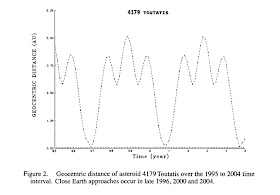4179 Toutatis was discovered by C. Pollas at Caussols (France) on January 4, 1989. 4179 Toutatis was first sighted on February 10, 1934, as object 1934 CT, and then promptly lost. It remained a lost asteroid for several decades until it was discovered by Pollas.
According to Minor Planet Circ. 16444: "Named after the Gaulish god, protector of the tribe. This totemic deity is well known because of the cartoon series "Les aventures d'Asterix" by Uderzo and Goscinny. This tells the stories of two almost fearless heroes living in the last village under siege in Roman-occupied Gaul in 50 B.C., and whose only fear is that the sky may fall onto their heads one day. Since this object is the Apollo object with the smallest inclination known, it is a good candidate to fall on our heads one of these days... But as the chief of the village always says: "C'est pas demain la veille..." Citation written by the discoverer and A. Maury and endorsed by J. D. Mulholland, who with Maury obtained the discovery plates."
According to Minor Planet Circ. 16444: "Named after the Gaulish god, protector of the tribe. This totemic deity is well known because of the cartoon series "Les aventures d'Asterix" by Uderzo and Goscinny. This tells the stories of two almost fearless heroes living in the last village under siege in Roman-occupied Gaul in 50 B.C., and whose only fear is that the sky may fall onto their heads one day. Since this object is the Apollo object with the smallest inclination known, it is a good candidate to fall on our heads one of these days... But as the chief of the village always says: "C'est pas demain la veille..." Citation written by the discoverer and A. Maury and endorsed by J. D. Mulholland, who with Maury obtained the discovery plates."
4179 Toutatis is a highly irregular body consisting of two distinct "lobes", with maximum widths of about 4.5 km and 2.4 km respectively (4.5 × 2.4 × 1.9 km; absolute magnitude H=15.3) and it had a close approach with Earth at about 18 LD (Lunar Distances = ~384,000 kilometers) or 0.0463 AU (1 AU = ~150 million kilometers) at 0640 UT on Dec. 12, 2012. Its magnitude will be between 10.5 to 11 from December 11 through December 23, 2012.
Moreover, Toutatis will be the target of a flyby by the Chinese Chang'e 2
spacecraft on December 13, 2012 Chang'e 2 was originally launched to
study the Moon but was diverted in April, 2012 for the asteroid
encounter.
We performed some follow-up measurements of this object just few hours before its 2012 close approach, from the I89 iTelescope network (Nerpio, Spain) on 2012, Dec. 11.9, through a 0.15-m f/7.3 refractor + CCD. Below you can see our image, single 120-second exposure, taken with the asteroid at magnitude ~10.5 and moving at ~20.7"/min. The asteroid is trailed in the image due to its fast speed. At the moment of the close approach 4179 Toutatis will move at ~ 21.86"/min. Click on the image below to see a bigger version. North is up, East is to the left.
Below you can see a short animation showing the movement of 4179 Toutatis (40 consecutive 10-second exposures). East is up, North is to the right. Click on the thumbnail for a bigger version:
Toutatis passes by Earth’s orbit roughly every 4 years. Four years ago
it didn’t come quite so close (0.0502 AU). But four years before that
(in September 2004) it missed us by just 0.0104 a.u., less than a
quarter of its distance this time. The next notable close approach of
Toutatis will be November 5, 2069, when the asteroid will fly by at a
distance of only 0.0198 AU (7.7 lunar distances). See graphs below (click
on it for bigger versions).
 |
| Credit: Hazards Due to Comets & Asteroids by T. Gehrels - University of Arizon Press |
 |
| Credit: Hazards Due to Comets & Asteroids by T. Gehrels - University of Arizon Press |
Thanks to its proximity and size Toutatis was a strong target for radar imaging. Astronomers of NASA's Goldstone radar were tracking the asteroid as it passes by Earth and they obtained images of unprecedented clarity. Click on the image below for a bigger version.
 |
| 2012 Goldstone Radar Observations of (4179) Toutatis |
According to radar team member Michael Busch: "Toutatis appears to have a complicated internal structure. Our radar measurements are consistent with the asteroid's little lobe being ~15% denser than the big lobe; and they indicate 20% to 30% over-dense cores inside the two lobes.". This raises the interesting possibility that asteroid Toutatis is actually a mash up of smaller space rocks. "Toutatis could be re-accumulated debris from an asteroid-asteroid collision in the main belt," he says.
UPDATE - December 18, 2012
The Chinese Chang'e 2 spacecraft has successfully imaged Toutatis during his flyby on December 13, 2012. See image below captured at 93–240 km distance between 16:30:09–16:30:24, maximum resolution 10 meters/pixel. Click on the image for a bigger version.
by Ernesto Guido & Nick Howes




ReplyDeleteThis is the first time I've heard anyone give a definite (more or less) return frequency for a PHA. I've not been able to find a site online (that I can understand) that gives this info...
TXS.
I left this question as a comment on photobucket, but thought I should maybe ask it here as well. There are several small objects moving from lower right to upper left in the multi-frame sequence of the close approach. Why? What is that?
ReplyDeleteDear Bob, the animation has been made with 40x10-second exposures. The faint objects you see in the animation are only "noise" from the ccd camera.
ReplyDeleteErnesto